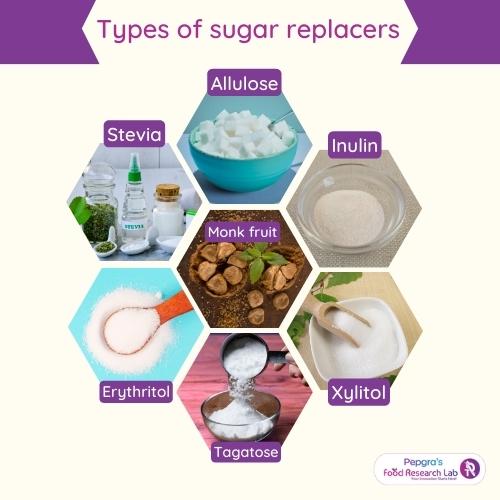
What are recent different sugar replacers available in the market?
Introduction
Sweet is a taste which many enjoy and is associated with celebrations and rewards. The sweet taste in the confectionaries, chocolates and desserts is, by and large, contributed by sugar. However, consuming excessive sugar has adverse outcomes. Evidence from clinical studies suggests that sugar is a causative agent for chronic conditions and diseases like type-2 diabetes, obesity, cognitive and attention deficit disorders and tooth decay/dental caries. In addition, those who consume excess sugar are at a higher risk for cancer. Therefore, the WHO recommends limiting sugar to 10% of the total caloric intake [1].
The Food and beverage industries are boggled with formulating food with lesser sugar that would give the same sensory characteristics as sugar. They are also aware of the changing consumer preferences for low-calorie products. Sugar replacers can solve the challenge of developing products with fewer calories. Sugar replacers can be natural or synthetic/artificial [2]. In addition, evidence from clinical studies have suggested that sugar replacers are safe when consumed in moderation.
Commonly available sugar replacers
There are several different sugar replacers available in the market today. Some of the commonly available ones in the market are:

- Stevia: The leaves of the Stevia rebaudiana, a plant native to South American countries like Brazil, Argentina and Paraguay, yield a high-intensity sweetener called stevia and has become a popular sugar replacer. Stevia is up to 300 times sweeter than sugar, has no calories, and does not raise blood sugar levels, making it diabetic-friendly [3].
- Erythritol: A sugar alcohol called erythritol occurs naturally in some fruits and fermented foods. It has a similar sweetness to sugar but with only 6% of the calories, making it a suitable low-calorie sweetener. It does not cause tooth decay and has a low glycaemic index. It finds its application as an ingredient in food and beverages and as a constituent in medicine [4].
- Allulose: Allulose is a rare sugar that occurs naturally in some fruits. The texture and taste of allulose are similar to sugar but with only 1/10th of the calories. Allulose can be categorised as an alternative sugar, and studies have shown that it can reduce blood sugar levels and enhances lipid metabolism [2].
- Monk Fruit: The juice of monk fruit, a plant native to China, is a sweetening agent. It is up to 200 times sweeter than sugar, has no calories, and does not raise blood sugar levels. It is rapidly gaining popularity, making it second only to stevia [5].
- Tagatose: Tagatose is a low-calorie sugar substitute that is derived from lactose. The texture and taste are similar to sugar but with only 38% of the calories. It reduces the glycaemic load and does not cause tooth decay.
- Inulin: Inulin is a dietary fibre that can be used as a sugar substitute. It has a slightly sweet taste and can be combined with other sweeteners. It finds its use as a sugar replacer in cocoa- and coffee-based beverages. It enhances the mouthfeel and promotes gut health [2].
- Xylitol: Xylitol is a plant-derived sugar alcohol. Its sweetness is similar to sugar but has a low glycaemic index. It provides only 2/3rds of the calories, making it suitable for diabetics and in postoperative conditions when the glucose cannot be adequately utilised. Additionally, it does not cause tooth decay. It finds its application in developing food, confectionery, bakery, and pharmaceutical products [6].
Conclusion
Sugar replacers are in great demand nowadays since they contribute to sweetness and have fewer calories, making them a popular choice for weight watchers, health-conscious individuals and individuals with diabetes who do not want to miss out on sweets. There are many types of sugar replacers available in the market. They may differ in their properties and may not be suitable for everyone. Hence seeking the advice of a healthcare professional is recommended.
How the Food Research Lab can help
The Food Research Lab specialises in developing ingredients of the highest quality and following regulatory and safety guidelines. In addition, the team of experts takes all the precautionary measures to ensure that the product developed is free from contaminants and is formulated after cost analysis so that it is developed at a reasonable cost.





